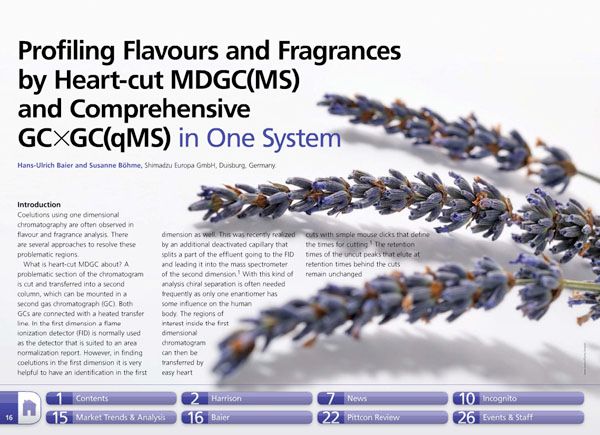Profiling Flavours and Fragrances by Heart-cut MDGC(MS) and Comprehensive GCxGC(qMS) in One System
Coelutions using one dimensional chromatography are often observed in flavour and fragrance analysis.
Coelutions using one dimensional chromatography are often observed in flavour and fragrance analysis. There are several approaches to resolve these problematic regions.
What is heart-cut MDGC about? A problematic section of the chromatogram is cut and transferred into a second column, which can be mounted in a second gas chromatograph (GC). Both GCs are connected with a heated transfer line. In the first dimension a flame ionization detector (FID) is normally used as the detector that is suited to an area normalization report. However, in finding coelutions in the first dimension it is very helpful to have an identification in the first dimension as well. This was recently realized by an additional deactivated capillary that splits a part of the effluent going to the FID and leading it into the mass spectrometer of the second dimension. With this kind of analysis chiral separation is often needed frequently as only one enantiomer has some influence on the human body. The regions of interest inside the first dimensional chromatogram can then be transferred by easy heart cuts with simple mouse clicks that define the times for cutting. The retention times of the uncut peaks that elute at retention times behind the cuts remain unchanged in the MDGC-2010 system without using any pressure corrections of retention times. This can be used by the recently described Multi-Deans Switch technology.
In contrast, comprehensive GC×GC(qMS) allows a one shot separation of complex mixtures (no enantiomeric separation). While in MDGC the total peak capacity is a sum of both columns N1 (1st dim) + N2 (2nd dim) in comprehensive GC×GC it is the multiplication N1∙N2 of both. In the latter, an orthogonal set of columns is usually used [i.e., a classical unpolar (polar) column is connected to a polar (unpolar) narrow bore column of about 1 m in length]. There are several modulation technologies available that can be grouped into thermal and flow modulation. For the latter, typical peak column flows of 10–20 mL/min are used and are, therefore, not as suitable for quadrupole MS detection, particularly because the flow dilutes the sample. As a result the sensitivity is drastically reduced. In this instance, thermal modulation with quadrupole detection was used.

Analytical Challenges in Measuring Migration from Food Contact Materials
November 2nd 2015Food contact materials contain low molecular weight additives and processing aids which can migrate into foods leading to trace levels of contamination. Food safety is ensured through regulations, comprising compositional controls and migration limits, which present a significant analytical challenge to the food industry to ensure compliance and demonstrate due diligence. Of the various analytical approaches, LC-MS/MS has proved to be an essential tool in monitoring migration of target compounds into foods, and more sophisticated approaches such as LC-high resolution MS (Orbitrap) are being increasingly used for untargeted analysis to monitor non-intentionally added substances. This podcast will provide an overview to this area, illustrated with various applications showing current approaches being employed.














